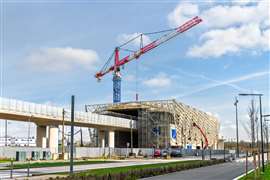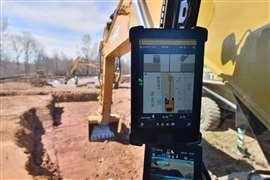Read this article in French German Italian Portuguese Spanish
May saw biggest fall in year-on-year US construction spending since 2019
02 July 2025
 Sunset over Los Angeles California showing construction of skyscrapers (Image: Jill Greer via AdobeStock - stock.adobe.com)
Sunset over Los Angeles California showing construction of skyscrapers (Image: Jill Greer via AdobeStock - stock.adobe.com)
May saw the biggest year-on-year decline in construction spending since 2019, according to new figures analysed by the Associated General Contractors of America (AGC).
Spending dropped for the fourth month in a row in May, down 0.3% from April and 3.5% from a year earlier.
That represented the biggest year-over-year decrease since February 2019, according to the AGC, which blamed growing uncertainty over potential new trade tariffs, labour policy and tax rates.
It said the lack of clarity over those issues has prompted many private sector developers to either delay or cancel projects.
The seasonally adjusted total construction spending in May was $2.1 trillion.
Of the various subsectors of construction only public construction increased, up 0.1% as compared to April and 3.3% from May 2024. Of the largest public construction categories, highway and street construction were down 0.3%, while spending on educational structures increased 0.1% and spending on transportation facilities increased by 0.6%.
Meanwhile, private non-residential fell by 0.4% month on month, with a year-on-year decrease of 3.9%. Spending on manufacturing plants, the largest private segment, slipped by 0.1% in May. Private power construction was down 0.6% and commercial construction dropped 0.8%.
Private residential construction dropped 0.5% for the month and 6.7% from May 2024.
Ken Simonson, chief economist of the AGC, said, “Uncertainty about tariffs, tax rates and labour availability are making it hard for many developers to risk moving forward with planned construction projects. While public sector demand remains solid, it just isn’t enough to offset the private sector pullbacks in activity.”
The AGC called on Congress and the Trump administration to eliminate the market uncertainties that are hitting confidence in the private sector.
It said that measures that could help the sector include passing legislation to avoid a large tax increase on construction firms and other sectors of the economy, as well as resolving the trade disputes that are prompting the proposed tariffs.
The AGC also called for new investments in construction education and training and more ways for people to enter the country lawfully to work in construction.
“The more certainty there is in the market, the more likely private sector developers will greenlight planned construction projects,” said Jeffrey D. Shoaf, the association’s chief executive officer. “Washington officials can help provide that certainty by setting clear tax rates, resolving trade disputes and addressing significant construction labour shortages.”
STAY CONNECTED



Receive the information you need when you need it through our world-leading magazines, newsletters and daily briefings.
CONNECT WITH THE TEAM










